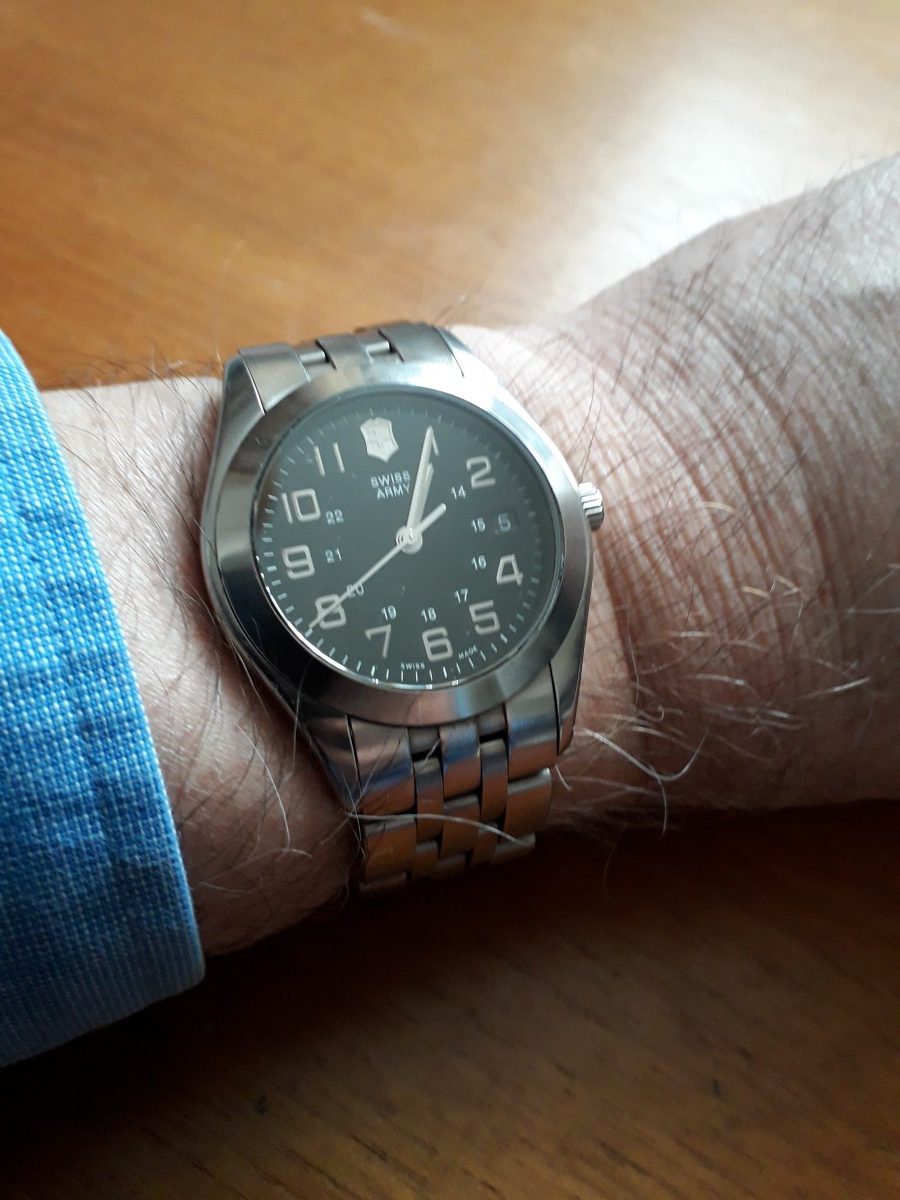By all that is holy, why am I doing an article on this humble Swiss timepiece? Well, firstly I am a little bored, but also it is actually a pretty damn good watch when I looked into further!
I happened upon this minor morsel whilst scanning James Kibble’s online timepiece vending business (KibbleWatches). In fact, I was after a Grand Seiko, but although there was one for sale it was not really the one for me. I did though purchase a very nice Presage Sakura Fubuki (noted in the article on the Grand Seiko Blue Snowflake a few months ago. Ed). Anyway, I noticed this Swiss Army piece and was attracted to same as: it looked OK, was in titanium, somewhat foolproof, apparently had a new battery, and finally, cheap at some £100. So, in the end I bought this at the same time as the Presage. When I actually received it I was quite impressed. Yes, there were a few scratches here and there, and it had no box, but it did have a small minimalist booklet. It was therefore ideal for my main reason for getting it – a beater for when I played sport or pottering in the garden.

To be frank, I knew little about Victorinox – other than for the ubiquitous Swiss Army Knife they make. Anyway, Master Cutler Karl Elsener opened a shop in Ibach, Switzerland in 1884. By 1891 he was supplying the Swiss Army with their standard soldier’s knife. After the death of his mother, Victoria, in 1909, he registered her name and the Cross & Shield emblem as trademarks. A little later the name inox was added, being the shortened name for inoxydable – the French for rust-resistant steel (so, stainless steel). Karl amalgamated the names and Victorinox was born. After WW 11, their penknives became very popular, with numerous versions that included a variety of useful tools. In 1989 they entered the watch market in the US under the brand name Swiss Army, and then globally in 2002 as Victorinox Swiss Army. Today, the company sells a range of watches and travel luggage, mostly designed for outdoors and sporting activities. Also, knives!

Since obtaining the watch it has grown on me, so have actually worn a fair bit. In view of this I decided to deal with the scratches – in particular two quite deep ones on the bezel. I have a Dremel with a pretty good polishing kit and hey, it worked out pretty well! I also had a go at the whole watch/bracelet and, again, it is much better. No, I would not use my method on any remotely quality watch, so please do not attempt!

So, what have we got. Well, the case is 38 mm x 9 mm and has a really nice shape, with the lugs flowing seamlessly from it. The crown is slightly recessed into the case and is the right size and shape with the etched logo on the end. The dial is black, with the hands, outer numbers and insignia in a shiny metal of some sort. There are also small white 24 hr numbers inboard. A small date window at 3. All is topped by a non-reflective sapphire crystal. The case back is a solid screw type and helps to offer 100 m water resistance. The bracelet is nicely integrated into the case and lugs, with two large links outboard and two thinner ones inboard. It has a butterfly clasp operated by two spring buttons either side. The mechanics – well, some kind of quartz movement that should be Swiss in origin, but I did note on some website or other that it could be from Seiko. Anyway, it seems to be pretty accurate so stick a new battery in every couple of years or so and that’s that! As to vintage, bearing in mind the full name on the reverse – probably mid-2000’s.

For a “ton” I am pretty pleased – bearing in mind new it was some $440! The watch looks nice, is in a tough, light (16 oz) and anti-corrosive metal, and seems to be accurate/reliable. The only one omission is that there no lume at all – otherwise it would be perfect! Oh, and other brands note: The bracelet clasp has the easiest action of all my watches!
Rating: 4.5/5
Note: The Alliance is still made but at 40 mm and in stainless steel. Prices from £380.

